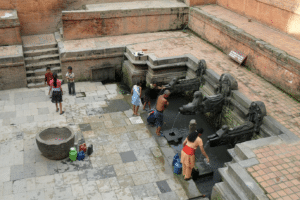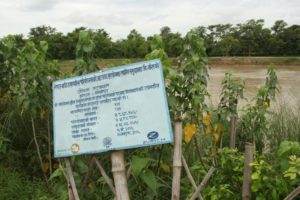Indigenous ingenuity: tapping into ancestral water management knowledge
Around the world, communities are drawing on generations of ancient water management know-how to turn the tables on climate change. In this post, we share successful examples of indigenous ingenuity from Peru, Nepal and Sudan that are helping people manage water despite the changing climate.
The need for water management
Climate change is making weather patterns more erratic and causing longer periods of drought followed by more destructive downpours. Among the hardest hit are smallholder farmers. Their crops frequently die; sometimes because they don’t get enough water, sometimes because they’re washed away by floods. Water for drinking and washing can also be scarce, while flood water damages homes and businesses.
Water management solutions are needed so that people can irrigate their farmland, have easy access to drinking water and protect their communities from floods.
Traditional know-how
Indigenous populations have survived for centuries, adapting to adverse climate conditions and building sustainable livelihoods. Their diverse knowledge, deeply rooted in their relationships with nature, has allowed many communities to maintain a sustainable use and management of water while protecting their environment.

In the Andes, ancient lagoons (amunas) are being reconstructed using indigenous techniques.
“Traditional and indigenous knowledge, adaptation and coping strategies can be major assets for local response strategies.”
UN, Realizing the Future We Want, 2012
Ancestral water management solutions are often small in scale and nature based. They’re usually affordable, use locally available materials and can be built and maintained by the community themselves. This also makes them sustainable, which is especially important in remote areas.
Indigenous water management solutions have often been adapted many times over decades, to take account of changing weather patterns and populations. This ‘built-in’ flexibility makes them ideal for adapting to the changing climate.
Peru’s ancient amunas
The dry climate in the western part of the central Andes means that communities here have always experienced water shortages. Beginning in the 15th century, farmers developed a series of water management techniques that allowed them to grow crops and raise livestock on land where it would have been otherwise impossible.
We met Gregorio Rios recently in Peru. He’s been working for decades to promote ancestral techniques for water management. He’s especially passionate about the reconstruction of a series of infiltration lagoons on the summit of the Marcahuasi plateau.

Gregorio Rios at the site of the ancient amunas in the Peruvian Andes.
Gregorio explained how the lagoons are created with the help of masonry dykes in the wide ravines on the plateau. “The water is diverted to these dykes by channels and cobblestones,” he told us. This system of channels is known locally as mamanteo, a term derived from the Spanish word for suckling, or amunas.
The lagoon water then filters through fractures in the rock, which has two benefits:
1. It reduces the surface runoff that often causes landslides, which destroy crops.
2. The water can be used to irrigate farmland in the dry valleys.
These pre-Inca techniques were overlooked for decades, but interest in the techniques has resurfaced recently. The growing populations of large cities, such as Lima, calls for more water and more efficient water management systems. That’s why, after decades of neglect, attention is turning to the infiltration dykes, amunas and other solutions developed hundreds of years ago by the indigenous people of the Peruvian Andes. Gregorio told us that he’s now partnering with local authorities to help reconstruct the amunas of the Marcahuasi plateau.
Nepal’s age-old dhunge dharas
A dhunge dhara, or hiti, is a traditional Nepalese stone drinking fountain. Intricately carved stone waterways carry water to the fountains from underground sources. Dhunge dharas are part of a comprehensive drinking water supply system, which dates back to ancient times. An elaborate network of water bodies supplies the fountains, which serve as a water resource during the dry season and help relieve water pressure caused by monsoon rains.

Manga Hiti, in Patan, is considered to be the oldest working dhunge dhara on record – it was built in 570 AD.
After the introduction of modern, piped water systems, starting in the late 19th century, some parts of the old system of dhunge dharas fell into disrepair. However, in more remote areas they remained the main source of drinking water for whole communities, especially in the dry season.
“The source of dhunge dhara are springs, recharged by traditional systems of ponds. Dismantling of these ponds and erratic rain patterns has led to drying of springs and less water in the dhunge dhara. Use of the ingenious techniques of rehabilitating ponds, gully plugging to slow down the surface run-off in the upstream, plantation and protecting the spring catchment from grazing, directing the surface run-off towards infiltration trenches in the spring catchment – are reviving the springs and dhunge dhara.”
Bikram Rana, Practical Action, Nepal
More recently, interest in this ancient water management system has grown, as Nepal adapts to longer dry spells caused by climate change. After decades of neglect, dhunge dharas, and the age-old network of wells and ponds that supply them, are being restored. It’s another example of ancient knowledge being used to adapt to the new challenge of climate change.
Much of our water management work in Nepal uses indigenous know-how, including the repair of systems of canals and building bio-dykes (embankments made from natural materials). As well as providing water for people and animals, these solutions are also reducing the impact of natural hazards. For example, the 220m-long bio-dyke on the Karnali River in Nepal is protecting the property, possessions and crops of 135 households from flooding.
The 220m-long bio-dyke on the Karnali River in Nepal was built by the local community with our support, using natural, locally-available materials.

The 220m-long bio-dyke on the Karnali River in Nepal was built by the local community with our support, using natural, locally-available materials.
Sudan’s traditional hafirs
Blue Nile, in Sudan, is a semi-arid region where rainfall is low and other sources of water, such as groundwater or surface water, are rare. Climate change means North Sudan is getting even drier. Once again, an ancient solution holds the key to water management in this remote area.
A hafir is an artificially constructed catchment basin dug in a low-lying area that collects rainwater, allowing it to be stored for drinking during the dry season and times of drought. Hafirs have been constructed by North Darfur’s indigenous communities since ancient times using locally-available materials. Often constructed with circular earthen walls, Hafirs are almost unique to Sudan, where there are around 1,500 of them.

The “Great Hafir” at Musawwarat es-Sufra
Hafirs may have been around for centuries, but they are more vital now than ever. That’s why we’re working with communities in the Blue Nile region of Sudan to rehabilitate existing hafirs and build new ones using ancient techniques, so they can continue to provide vital sources of water for people and animals.
“We’re working with communities to rehabilitate the traditional hafirs and the way they are managed, to ensure they are well maintained and not contaminated. This is being done by building fences to prevent animals from getting into the water also providing a pump that takes the water to separate points for animals and humans. For new hafirs, we conduct studies of the soil to determine the best location.”
Rofaida Elzubair, Practical Action, Sudan
Solutions that work – for everyone
Indigenous people often struggle to maintain their rights, traditions and knowledge in a system dominated by a western world view. They are frequently marginalised and subject to discrimination. By taking indigenous people’s knowledge and their needs as our starting point, we can make sure their contribution isn’t overlooked and that they benefit from the water management solutions they have helped develop.
Communities around the world can successfully manage their water needs despite the changing climate. The knowledge held by indigenous communities is a vital ingredient when it comes to turning the tables on climate change. With ingenuity, more people can adapt to the challenges created by the climate crisis, using techniques that improve their livelihoods while protecting their natural environment.
Donate now and make more amazing things happen.